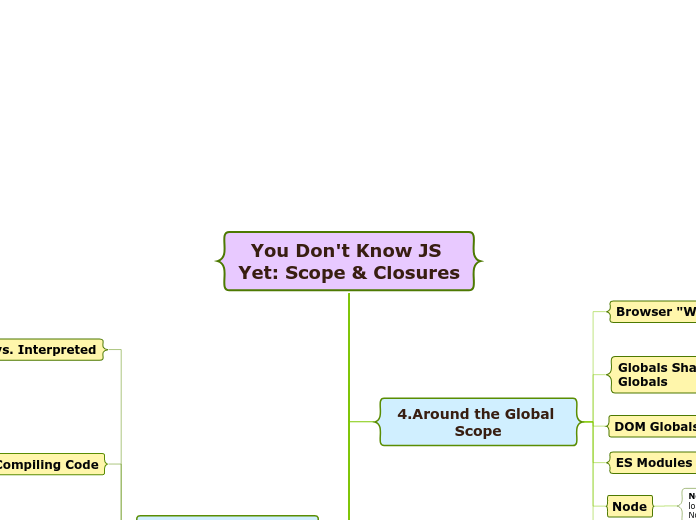You Don't Know JS Yet: Scope & Closures
4.Around the Global Scope
Browser "Window"
With respect to treatment of the global scope, the most pure environment JS can be run in is as a standalone .js file loaded in a web page environment in a browser
Globals Shadowing Globals
An unusual consequence of the difference between a global variable and a global property of the same name is that, within just the global scope itself, a global object property can be shadowed by a global variable
DOM Globals
ES Modules (ESM)
all variables that exist in the global scope are available as lexical identifiers from inside the module's scope.
Node
Node treats every single .js file that it loads, including the main one you start the Node process with, as a module
Global This
Global this = window
5.The Secret Lifecycle of Variables
Hoisting: Declaration vs. Expression
Function hoisting only applies to formal function declarations, not to function expression assignments
Variable Hoisting
The const keyword requires a variable to be initialized, so omitting an assignment from the declaration results in a SyntaxError
JS engine hoists the variables declared using the let keyword, but it doesn't initialize them as the variables declared with the var keyword.
Loops
for... for..in and for..of loops: the declared variable is treated as inside the loop body, and thus is handled per iteration
1.What's the Scope?
Compiled vs. Interpreted
Code compilation is a set of steps that process the text of your code and turn it into a list of instructions the computer can understand.
Interpretation the source code is transformed line by line
Compiling Code
1.Tokenizing/Lexing: breaking up a string of characters into meaningful (to the language) chunks, called tokens.
2.Parsing: taking a stream (array) of tokens and turning it into a tree of nested elements, which collectively represent the grammatical structure of the program
3.Code Generation: taking an AST and turning it into executable code.
Required: Two Phases
Syntax Errors from the Start
Early Errors
Hoisting
Compiler Speak
Targets (assignment operation)
Sources
Cheating: Runtime Scope Modifications
The eval(..) function receives a string of code to compile and execute on the fly during the program runtime
The with keyword, which essentially dynamically turns an object into a local scope
Date
Event
Highlights
Highlights
Event
Highlights
Highlights
2.Illustrating Lexical Scope
When the code wants to access a variable – the inner Lexical Environment is searched first, then the outer one, then the more outer one and so on until the global one.
6.Limiting Scope Exposure
Invoking Function Expressions Immediately
defining a function expression that's then immediately invoked.
IIFE is useful when we want to create a scope to hide variables/functions
Scoping with Blocks
In general, any { .. } curly-brace pair which is a statement will act as a block
What's the Catch?
The try...catch construct allows to handle runtime errors. It literally allows to “try” running the code and “catch” errors that may occur in it.
3.The Scope Chain
Shadowing
If you need to maintain two or more variables of the same name, you must use separate (often nested) scopes
Global Unshadowing Trick
window.variableName
Function Name Scope
Function declaration immediately becomes a ready-to-use function
Function expressions is created when the execution reaches it and is usable only from that moment
Arrow functions don't bind their own scope, but inherit it from the parent one, which in this case is window or the global object.
7.Using Closures
Observational
Closure is a function instance remembering its outer variables even as that function is passed to and invoked in other scopes
Implementational
Closure is a function instance and its scope environment preserved in-place while any references to it are passed around and invoked from other scopes
The benefits
Closure can improve code readability, bounding scope-exposure by encapsulating variable(s) inside function instances, while still making sure the information in those variables is accessible for future use
Closure can improve efficiency by allowing a function instance to remember previously determined information instead of having to compute it each time.
8.The Module Pattern
Encapsulation
The goal of encapsulation is the bundling or co-location of information (data) and behavior (functions) that together serve a common purpose.
What Is a Module?
A module is a collection of related data and functions (often referred to as methods in this context), characterized by a division between hidden private details and public accessible details, usually called the "public API."
A module is also stateful: it maintains some information over time, along with functionality to access and update that information.
Node CommonJS Modules
CommonJS modules are file-based; one module per file.
Modern ES Modules (ESM)
ESM is file-based, and module instances are singletons, with everything private by default.
